After almost 11 years, the development of the MSBS-5,56 family is coming to the conclusion. The joint effort of Military University of Technology (Wojskowa Akademia Techniczna, WAT) and Fabryka Broni Łucznik-Radom company should reach its final shape in 2021.

Mockups of MSBS-5,56B carabine, marksman rifle, and machine gun
Modular system
In the meantime, based on the 5,56×45 mm firearms, variants for other ammunition types are also created. Rifles for 7,62×39 mm ammunition, with a lower receiver modified to accept the standard AK/AKM magazine and for the 7,62×51 mm ammunition will be created first. The second one, in the semi-auto variant, is offered for the Polish Army as a replacement for obsolete, soviet SWD marksman rifles. Fabryka Broni also developed a conversion kit for the Ultimate Training Munition UTM MMR and Simunition FX training rounds. Further plans include creation of 9×19 mm submachinegun, based on the MSBS construction. WAT has also prepared designs for semi-auto and pump action shotguns based on the MSBS platform. There are multiple possibilities, including conversions for 5,45×39 mm and 7,62×35 mm/.300 Blackout ammunition.

Michał Czyżewski is the lead constructor for RAWAT project’s bullpup service rifle from Łucznik
Origins
The main premise of the creators was to design a system which utilizes a common upper receiver. This upper would then be used as a foundation for other parts (including lower receivers in both classic and bullpup designs), to create options for various tactical needs. Design allows for construction of carabines, service rifles, rifles w/ grenade launchers, marksman rifles, and magazine fed support weapons. The user would be able to adapt the firearm to the task at hand. Quick change barrel and various modules can be swapped even in the field conditions.

MSBS-5,56B technology demonstrator. Polish design went a long way from its start in 2007
MSBS-5,56 Project
MSBS-5,56 development project started in 2007. The process was conducted by the Military University of Technology and Arms Factory from Radom. It was finished in 2011 with a creation of system’s general concept and 4 demonstration rifles in both classic and bullpup designs. These were first shown in 2009.
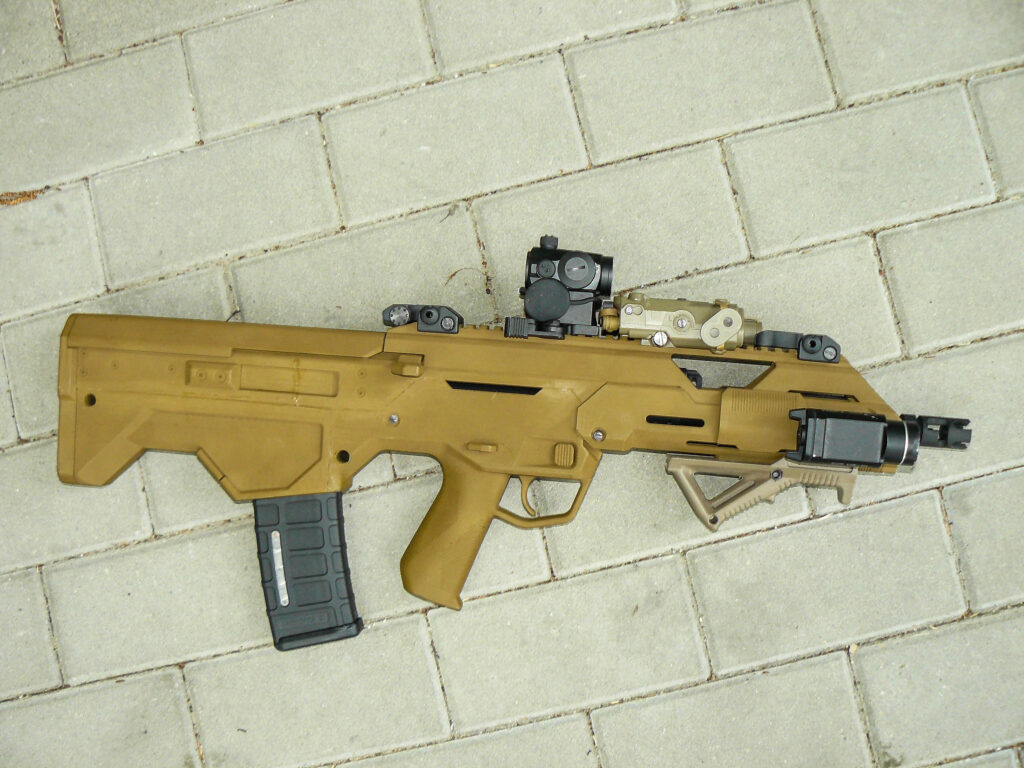
One of the mockups of the MSBS-5,56B created with 3D printing technology. There is a noticeable difference in ergonomics and functionality when compared to the demonstrator
MSBS Project
In November 2011, the development and implementation project called Modulowy System Broni Strzeleckiej MSBS (Modular Small Arms System) was started. It concerned refinement of previously created concept and full-scale manufacturing implementation. Classic design rifle with grenade launcher and bayonet was to be implemented first.
In August 2012, the first 4 classic design rifles were unveiled. A year later there were 12 MSBS-5,56 prototypes with serial numbers from KN00001 to KN00016. Next, the assembly of the first 100 MSBS-5,56 was the final element of this stage.
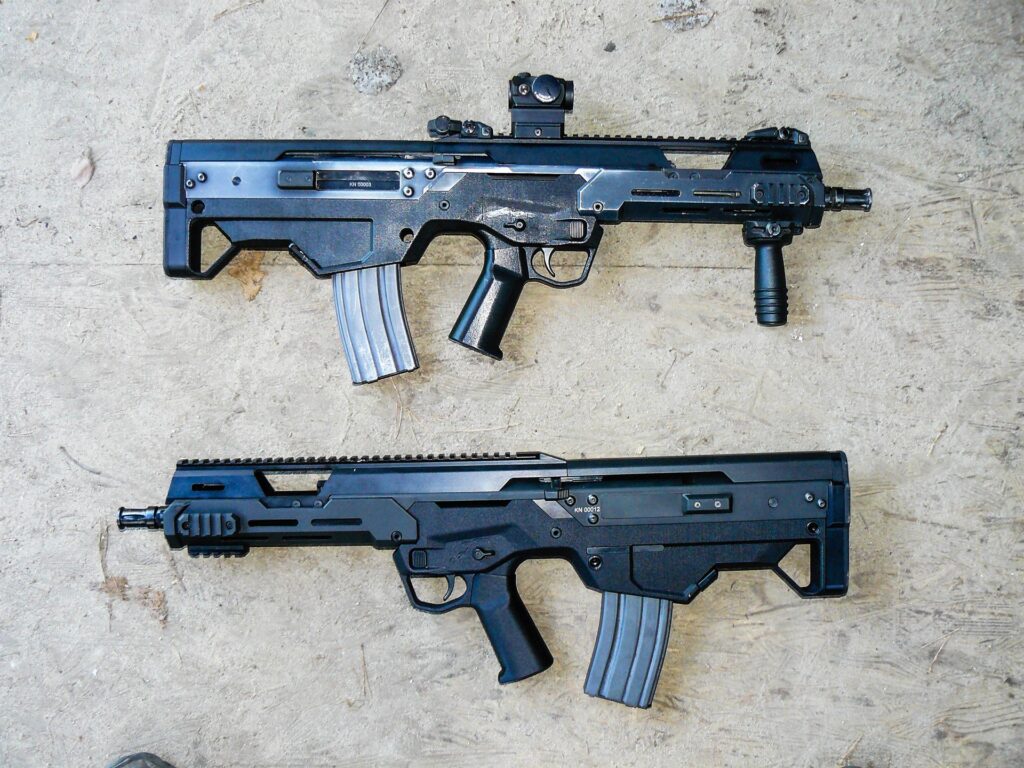
First of MSBS-5,56B bullpup rifles as presented in 2014
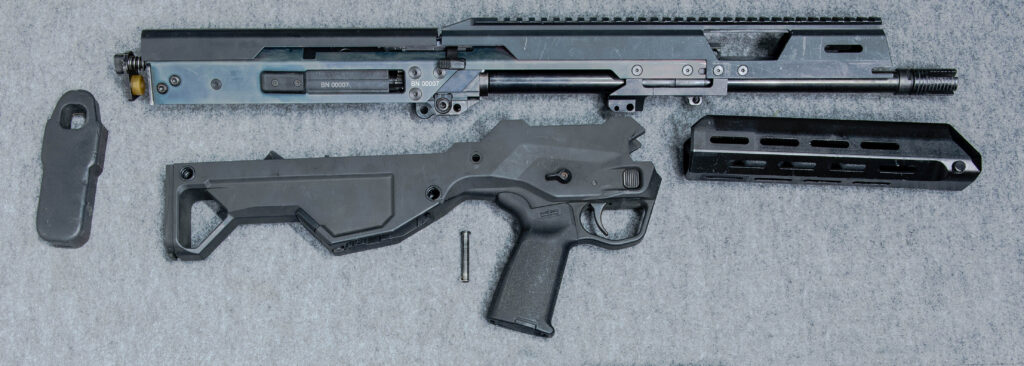
MSBS-5,56B partially disassembled. Common elements of the upper receiver are clearly visible
MSBS-5,56/RAWAT Project
On the 23rd of November 2012, the National Center for Research and Development (Nardowe Centrum Badan i Rozwoju, NCBR) judged the no. 3/2012 contest for defense and national security projects. Development of the MSBS-5,56 project was recommended for further financing. It would still be lead by Military University of Technology and Arms Factory. Between 2012 and 2016, 8 variants of the rifle would be constructed. The project received MSBS-5,56/RAWAT designation.
MSBS-5,56/RAWAT family was first presented in 2015, at the MSPO show. The team showed 2 of each classic variants (carabine, support weapon, marksman rifle), and 2 of each bullpup variants (carabine, service rifle, rifle w/ grenade launcher, support weapon, and marksman rifle).
MSBS and Tytan entanglement
Development of MSBS-5,56 rifle is tightly connected with the Tytan program. Formally, the relationship between the two projects started in 2006, when the Polish Army HQ created the operational requirements with the planned finalization date of 2019. Until present, qualification tests were performed upon MSBS-5,56KA1/Grot C16 service rifle, 40-mm GP underbarrel grenade launcher, knife/bayonet, and 9-mm PR-15 semi-auto handgun (renamed Vis 100 in December 2018). Interestingly, qualification tests were performed after the rifle development was disconnected from the Tytan program and when Territorial Defence Forces, in place of Land Forces, became the ordering party. Next stages of the project will involve examinations of the Grot C10 classic design carabine, the MSBS-5,56BA1/Grot B16 bullpup rifle and the 40-mm grenade launcher in its GS standalone variant. This is presumed to happen after 2019.

MSBS-5,56BA1/Grot B16 FB-M1 service rifle with 406-mm/16-inch barrel
Family planning
MSBS-5,56 system will consist of 5 variants for each classic and bullpup designs. All will fire the 5,56×45 mm NATO round and will be based on the common upper receiver serving as a base for other modules. For the classic MSBS-5,56/Grot C these modules are the lower receiver, handguard, barrel, and stock. For the MSBS-5,56B/Grot B bullpup designs the modules consist of: lower receiver, barrel, handguard (with a locating lock and 2 bolts), masking cover, butt pad housing, and the butt pad itself. The number of available handguards and stocks will increase over time.
All weapon controls are ambidextrous. The user can also rotate the bolt and switch the ejection port cover to change the ejection side. Barrel assembly has a 2-position gas regulator. Access to the regulator for the classic variant is straightforward. In the bullpup, gas regulator is adjusted through the opening the handguard.
Classic design rifles have a side-folding stocks with adjustable butt pad and cheek rest. Marsman version has a fixed stock, same as MSBS-7,62N, with an adjustable butt pad and cheek rest.
All MSBS-5,56 rifles have an easy to change barrel. This allows the firearm to be adaptable to battlefield conditions. The family will consist of 5 magazine-fed variants for each classic and bullpup designs.
When compared to Beryl rifles, MSBS-5,56 uses a different barrel twist rate. Wz. 96 Beryl has a 228 mm/1:9 twist (this ensures good stabilization of both the 5,56 g/55 gr and 4 g/62 gr NATO standard rounds). Twist rate for MSBS is 178 mm/1:6 inches.
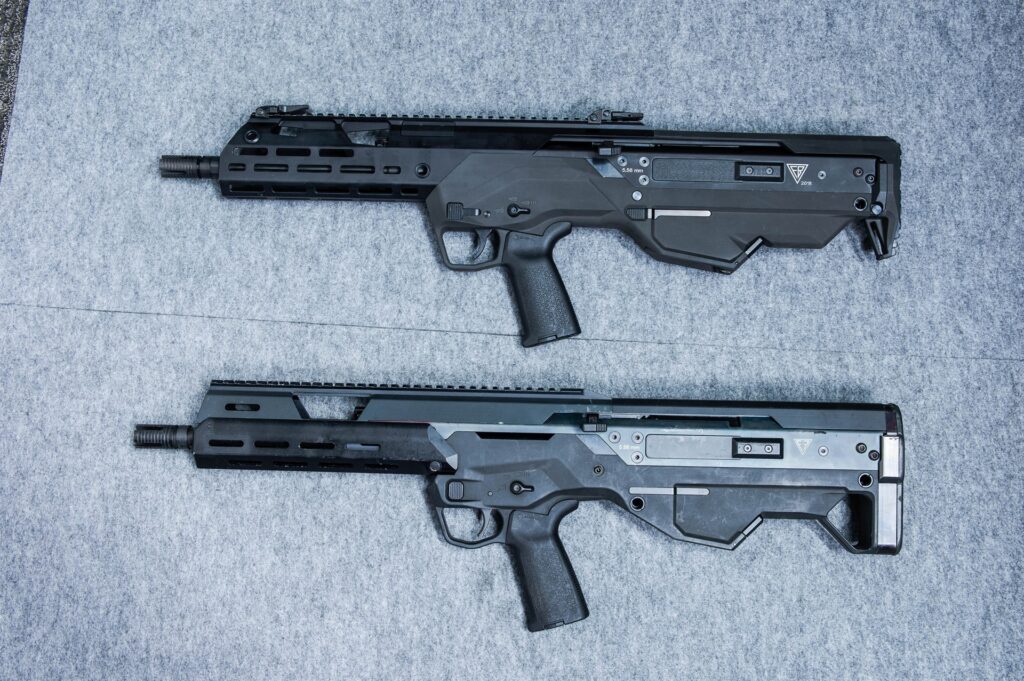
Comparison of current (up) and 2014 (down) MSBS-5,56/Grot B rifles
The first MSBS-5,56B
The premiere of the MSBS-5,56B bullpup rifle took place on the 21st of March 2014 at the shooting range in Piastow. The rifle was completed by the end of 2013 and the first shots were fired in 2014. The premiere was connected with an official opening of Łucznik’s new factory. Two models of the bullpup variant were shown in Piastow.
Lower receivers of the presented rifles differed from the previously shown mock-ups. The triangle-shaped opening appeared in the rear of the rifle, next to the butt. Controls location was almost identical to classic style firearm. The only difference is the lack of additional mag release button on the left side of the lower receiver.
Designers tried to minimize the distance between the pistol grip and magazine and between the grip and stock. The grip-magazine reduced distance affects the magazine change and makes this operation more similar to one performed with a classic variant rifle. The grip-stock distance is connected with the biggest disadvantage of bullpup design – an unnatural hand position. Designers wanted to ensure that the hand isn’t as far forward as in the older designs of bullpup weapons (FAMAS F1 or Steyr AUG A1).
MSBS-5,56B has a different bayonet mount. Instead of typical, under-barrel fitting, bullpup variant has an opening in for the bayonet’s handle in the handguard, above the barrel (similar to the H&K G3).
Models presented in 2014 had different trigger mechanisms. The difference in function was easily noticeable. Bullpups, due to long trigger bar connecting the trigger shoe with the firing group, usually require more force to operate than the classic design firearms.
There was a difference between the two 2014 bullpups as well – one was 0.15 kg lighter due to types of barrel used.

Differences in new (up) and old (down) versions of the lower receiver for the MSBS-5,56B rifle
The second generation of Grot B
Four long years have passed until Arms Factory unveiled the final version of the bullpup variants. This means that the 2018 rifles will undergo factory and qualification (government) testing. Tests will be conducted upon the Grot B16 service rifle, Grot B16 G rifle w/ grenade launcher, and the classic design Grot C10 carabine.
It’s been 3 years since Michał Czyżewski from Łucznik and Mirosław Zahor from WAT became responsible for the MSBS-5,56/RAWAT project. During those three years, bullpup variants were significantly refined and simplified. The number of elements required for bullpup conversion was reduced to 7. The elements are the lower receiver, handguard, positioning bracket with two bolts, butt pad housing and the butt pad itself. Conversion takes about 2-3 minutes, providing that the user has the correct tool.
Conversion
Handguard slides onto the upper receiver and is fixed in place with an aluminum bracket machined to match the accessory rail. The whole assembly is then fixed together with 2 bolts. This solution guarantees a rigid and repeatable connection. The lower receiver is attached next. It has a handguard fixing point in the front and the pinhole in the rear. The pin mounts into the butt pad housing. Thehousing itself has an opening for the recoil mechanism on one side and the other side is used to attach the L-shaped cover. It serves as a cheek pad and a butt pad. This solution simplifies the disassembly process. To disassemble the rifle, a pin is removed and the cover moves to the back. Remaining steps are the same as in the classic variant. The whole method of the handguard and receiver connection is quite innovative.
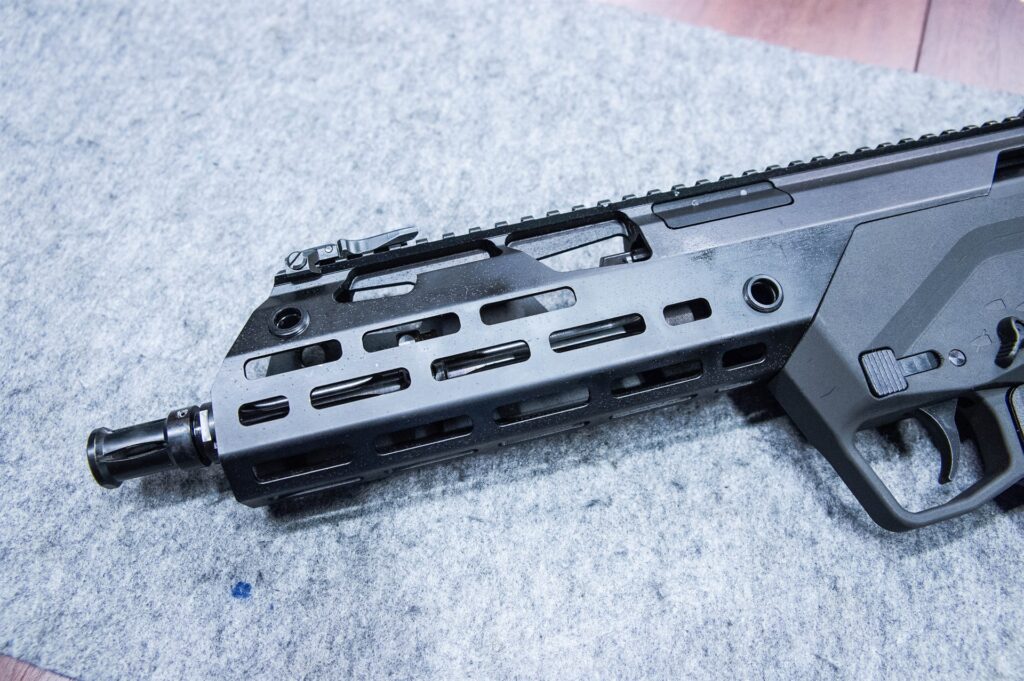
Simplified design of the handguard
Interior mechanics
The biggest challenge for the developers was the design of the trigger bar. The first generation of bullpups had a different mechanism than the classic variant. The current trend is to unify the firing assembly with the classic version. This, however, requires a cutout for the trigger bar and an extra element needed for the fire mode selection.
Moreover, a two-position trigger effect was introduced. When in full-auto mode, a light trigger press allows for single fire while a harder pull unleashes the automatic firing.
Movement of fire selector lever was also changed when compared to the 2014 version. At present going from safe to semi requires 90 degrees of travel. In the previous iteration, it was 45 degrees and the whole range of safety/selector switch was 90 degrees. Current model’s full-auto mode is 135 degrees from the safe position.
Magazine release was also modified. It was refined to assure faultless operation when either left or right release button is pressed. The new design allowed for additional springs removal and simplified the whole construction. On the left, above the magazine well, an additional release lever appeared to give the shooter more options.
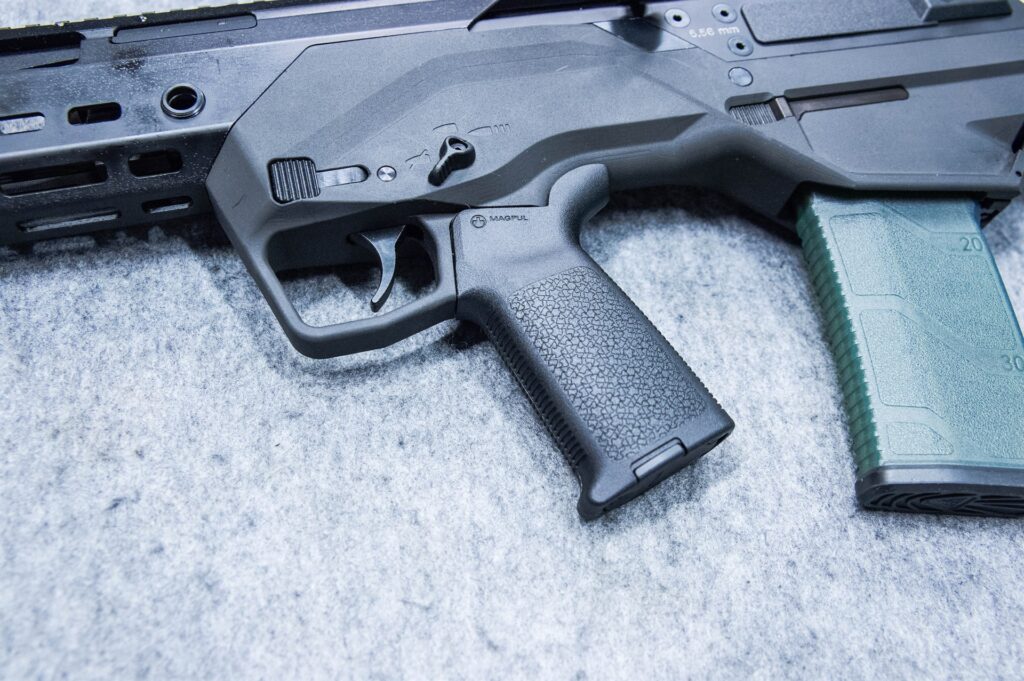
Safety/fire selector switch movement is 90 degrees from safe to single fire and 135 degrees from safe to full auto
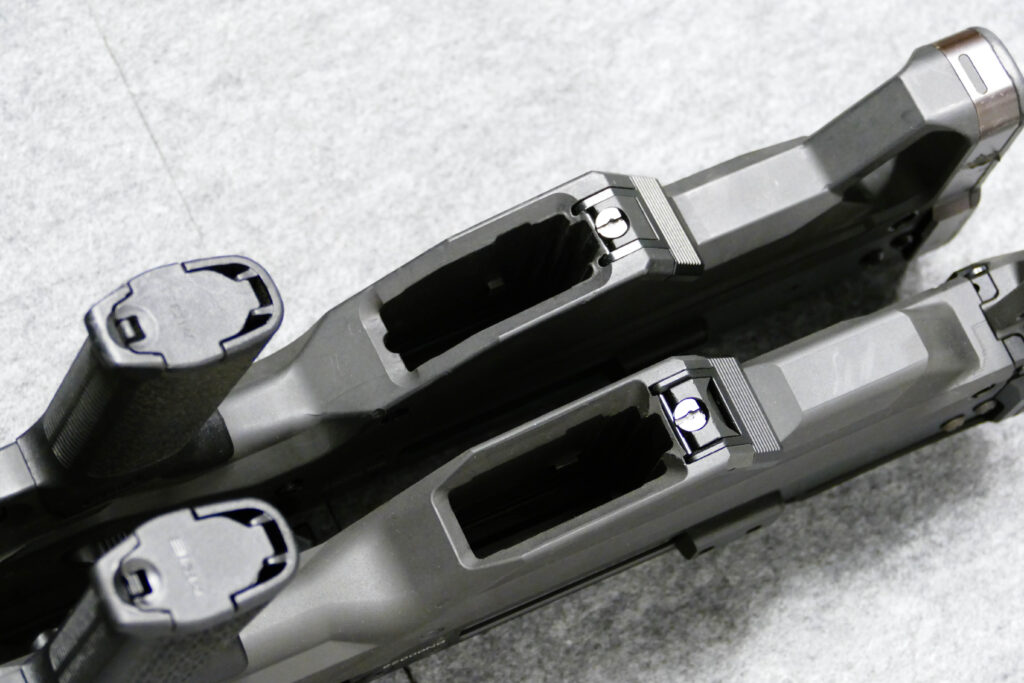
Magwell was changed. In the current version of MSBS-5,56B, the funnel is well pronounced and helps with guiding of the magazine

Bolt release in its updated, more ergonomic variant (left), compared to the old release (on the right)
Exterior
Quite a lot also changed on the exterior. Lower receiver was redesigned, with a grip moved slightly forward. Lower has a different profile and attaches to the handguard and the stock base in a different way. This solution eliminates a lot of extra components and is quite elegant from the engineer’s point of view. The handguard is not exchangeable with a classic design variant.
The handguard ends a bit further than the charging handle and is slightly longer than in 2014 rifle. It has a universal mounting rail and all sides, bottom, and diagonals are covered with Magpul M-LOK slots. The mounting system holes not only allow for fitting of accessories but also lighten the whole assembly. Handguard also has 4 QD connectors for a sling. Two are located on diagonal upper surfaces, other two on the sides, close to the lower receiver.
The cover/cheek pad/butt pad assembly is visually lighter than in the previous variant and is additionally strengthened by the sling mount. The assembly terminates level with the aluminum handguard. There are plans to introduce exchangeable butt pads, varying by material and thickness. In the presented rifles, these were made of elastomer material.
Ergonomy of the bolt catch is also improved. The lower receiver is trimmed at the end to form a triangular opening. This seems to be only an aesthetic change but the opening can be used for stabilization while shooting prone from a bipod. There are also plans to introduce more efficient case deflectors, similar to the ones used in MSBS-7,62N/SKBW.

The current version of MSBS-5,56B retains the additional mag release, located on the left of the lower receiver

The opening between the buttpad housing and the upper receiver can be used for additional stabilization

One of the potential buttpads. It has an FB logo and is made of an elastomer material
Carbine
The carbine variant is one of the most anticipated variants of the MSBS-5,56. It will probably have (yet to be confirmed by Arms Factory) a 256 mm/10-inch barrel. At present, testing of various barrel lengths is happening in Radom. Classic design has an open muzzle device, effective as a flash hider. The carbine does not allow for bayonet fitting. The bullpup version of the carbine has a different handguard then Grot B. Moreover, the front of the handguard allows for fitment of a hand-stop, preventing the shooters hand from venturing too close to the muzzle. Łucznik also plans on testing of a different, bigger deflector-type muzzle device for the carbine. It would eject some of the spent gases forward and reduce the weapon’s firing signature an concussion. There is ample space available to try that. Handguard has only two pairs of M-LOK openings, one on the top and one the bottom.
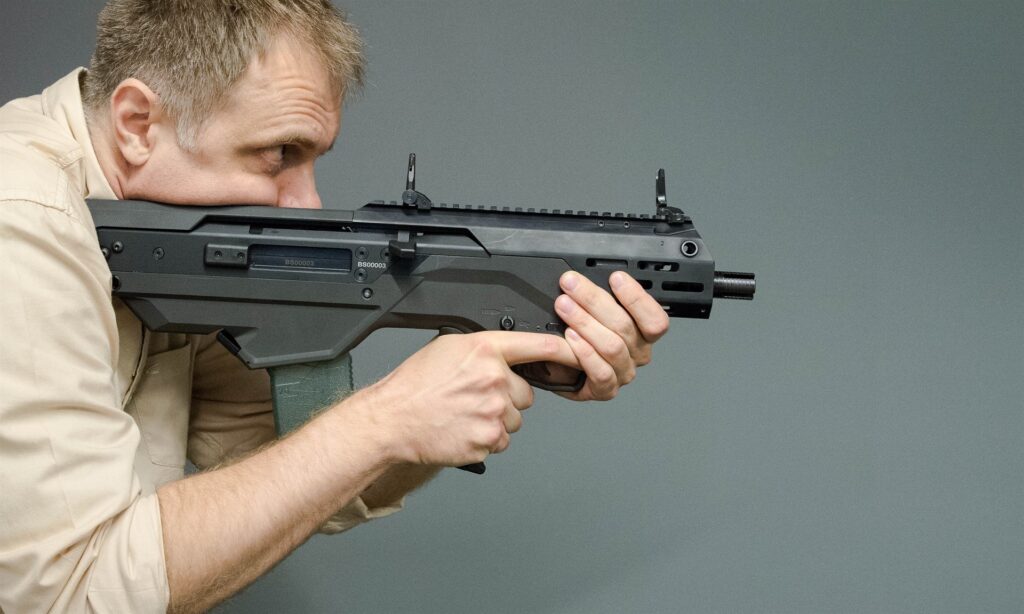
Grot B10 carabine with 254-mm/10-inch barrel is the shortest of the MSBS-5,56B family
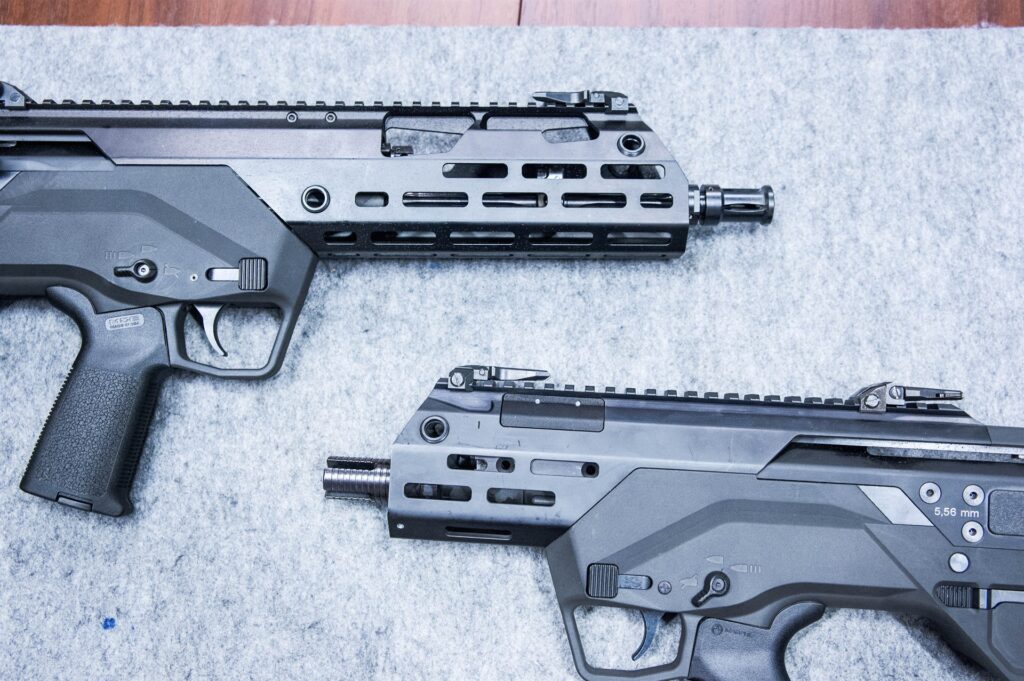
Carabine’s handguard is shortened when compared to other bullpup variants. The final version will have a handstop which prevents the fingers from venturing too close to the muzzle
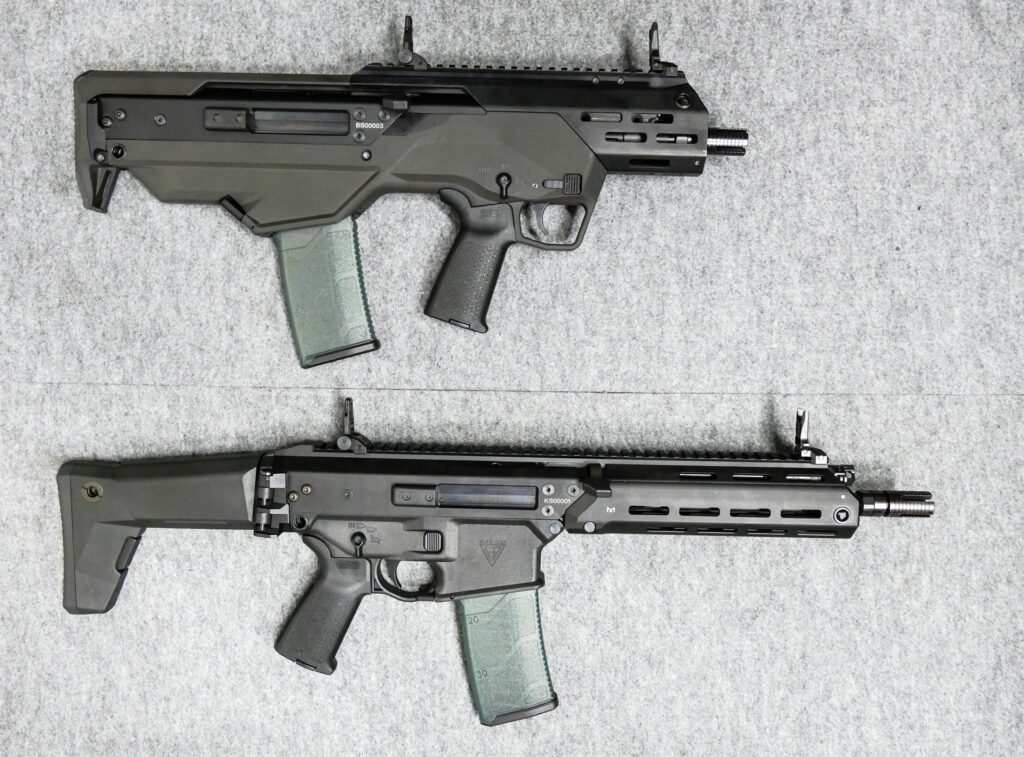
MSBS-5,56 system carabines in bullpup (up) and classic (down) designs. Both have 406-mm barrels
Service rifle
The Grot C16 service rifle is already used by Polish Armed Forces. The B16 bullpup version will have the same, 406-mm/16-inch barrel. The rifle will be compatible with a 40-mm underbarrel, single shot, GP grenade launcher. The bullpup has a bayonet mounting point above the barrel, opposite to the classic variant. This forced a change in the way of the muzzle device attachment and design. The bullpup’s muzzle device has just 4 openings, two directed diagonally to the top and two to the bottom. This solution was used to protect the handle of the bayonet. While working, it looks the barrel assembly will differ between the classic and bullpup variant. The barrels are interchangable, but the bullpup variant with a classic barrel will not have the ability to fit a bayonet.
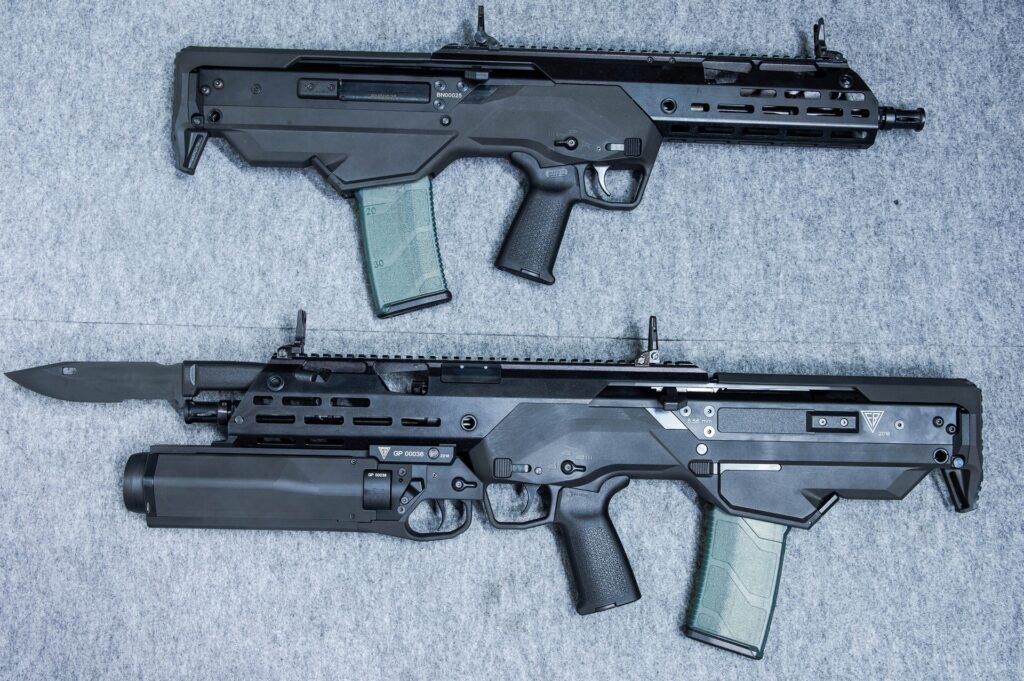
The Grot B16 service rifle (up) and the Grot B16 G rifle w/ grenade launcher (down) with the bayonet attached. In this configuration, the firearm is a part of the next stage of the Tytan program
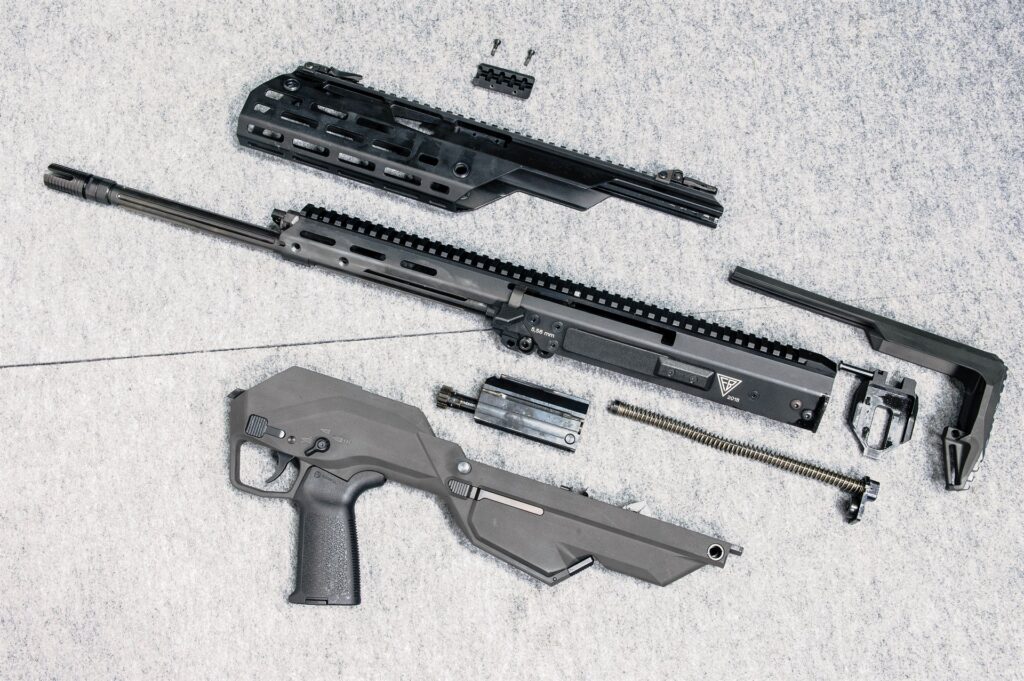
Bullpup variant is constructed by attaching of 7 elements to the common upper receiver
Machine gun
Grot C16 M and B16 M machine guns have heavier barrels, fitted with a muzzle device which effectively hides the flash. In theory, this model is meant to be used with high-capacity magazines. Surefire MAG5-60 were used for demonstration purposes.
The machine gun was designed for sustained fire so there is no bayonet attachment. The MSBS-5,56/RAWAT versions were tested with heavier barrels, with and without fluting. Current experiments will determine which solution works better for this model.

Grot B16 M machine gun (up) and Grot B20 PS (down) a bullpup variant
Marksman rifle
Marksman rifle is the final piece of the MSBS puzzle. Arms Factory produced prototypes of both Grot C20 PM and Grot B20 PM, each with 508-mm/20-inch barrels. Barrels are a bit lighter when compared to the machine gun model but were made more precisely. Muzzle device in the marksman model is compatible with a sound suppressor. When ready, the rifle will have a two-stage trigger. Similar as with the machine gun model, two types of barrels are under examination.

Together with the new bullpup rifles, Arms Factory presented their final version of the 40-mm, single shot, underbarrel GP grenade launcher

Grot C20PS marksman rifle has a long, 508-mm/20-inch barrel and a fixed stock with adjustable butt and cheek pad

Comparison of the marksman rifles. Grot C20PS (classic design) and Grot B20PS (bullpup design)
GP Grenade Launcher
A new version of 40-mm, single shot grenade launcher debuted at the MSPO show. New design in better integrated with the rifle. The old version had the trigger and the trigger guard located near the muzzle and the rear was formed in an angled grip. The new model is more classic in design, with the controls placed symmetrically on either side of the weapon. Both switches are in the form of large winglets. Barrel swivels to the left – this allows for any length of 40 mm x 46 SR ammunition to be used.
Modifications were forced by Polish Armed Forces requirements and the need to improve the ergonomics of the whole rifle-grenade launcher unit. Soldiers wanted a modular solution, usable as an underbarrel attachment and as a standalone grenade launcher.
For the Bullpups, mass is given without any additional accessory rails, magazines and with BUIS. Classic variants were equipped with 3 pieces of 6-slot accessory rails.
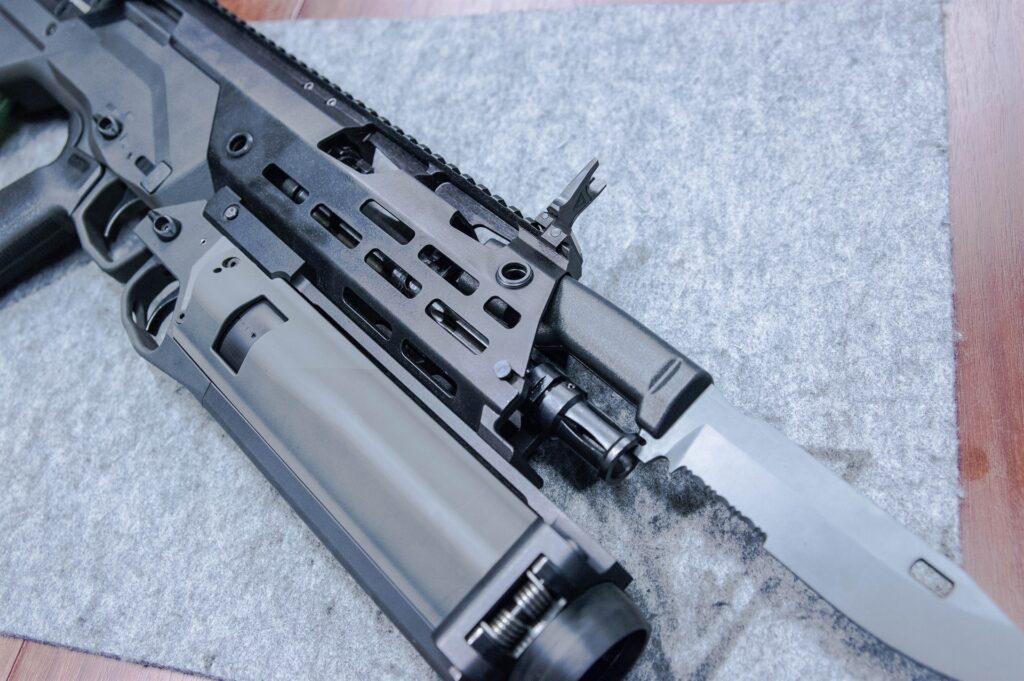
Details of the grenade launcher and bayonet attachments. In the bullpup configuration, the bayonet is rotated 180 degrees, compared to the classic design
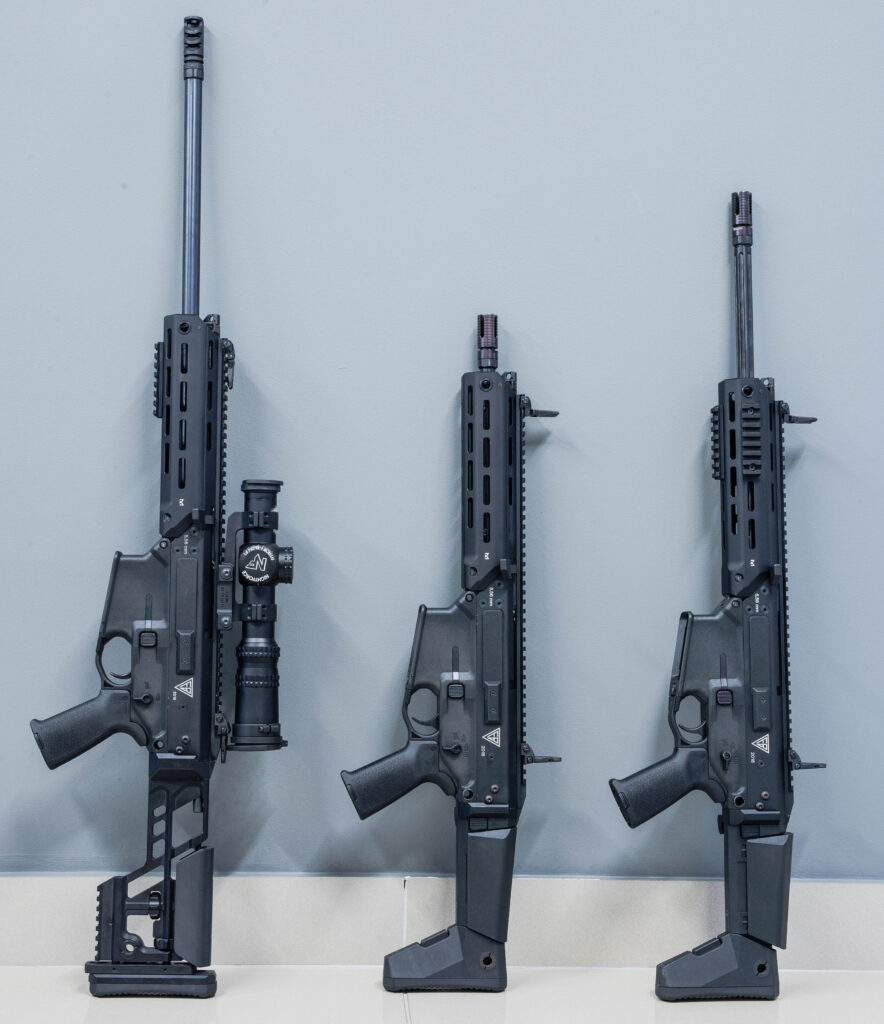
Final looks of the classic variant, supplementing the service rifle and the rifle-grenade launcher
This article was originally published on MILMAG 05-06/2018


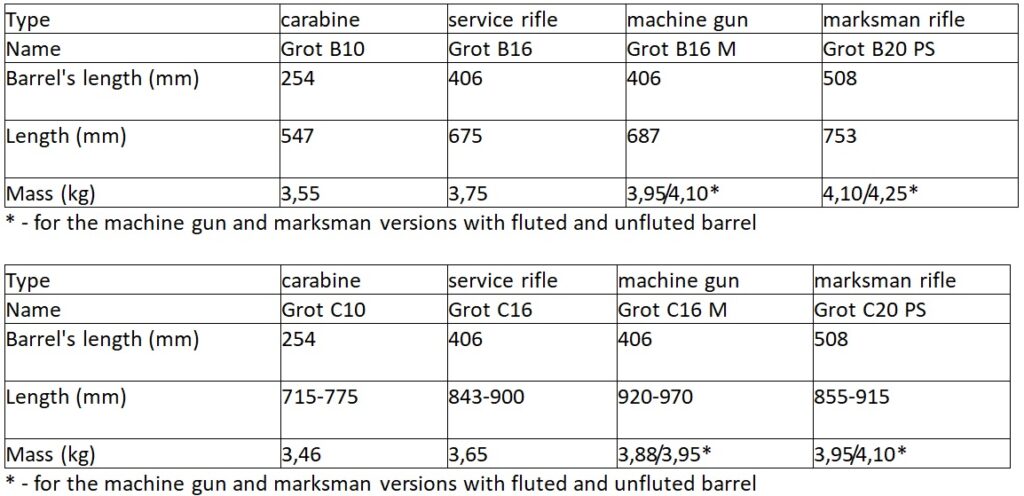

Comments
Nobody has commented on this article yet.